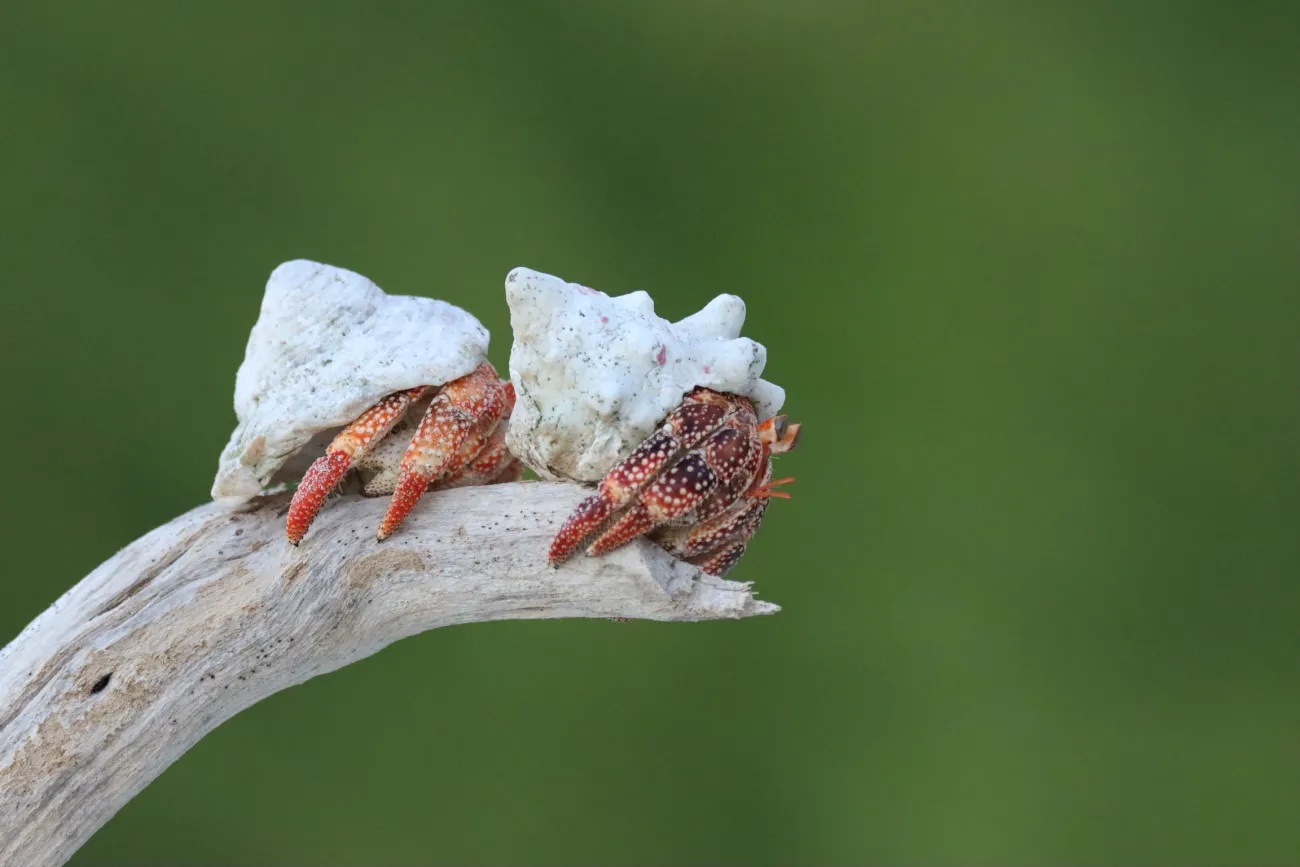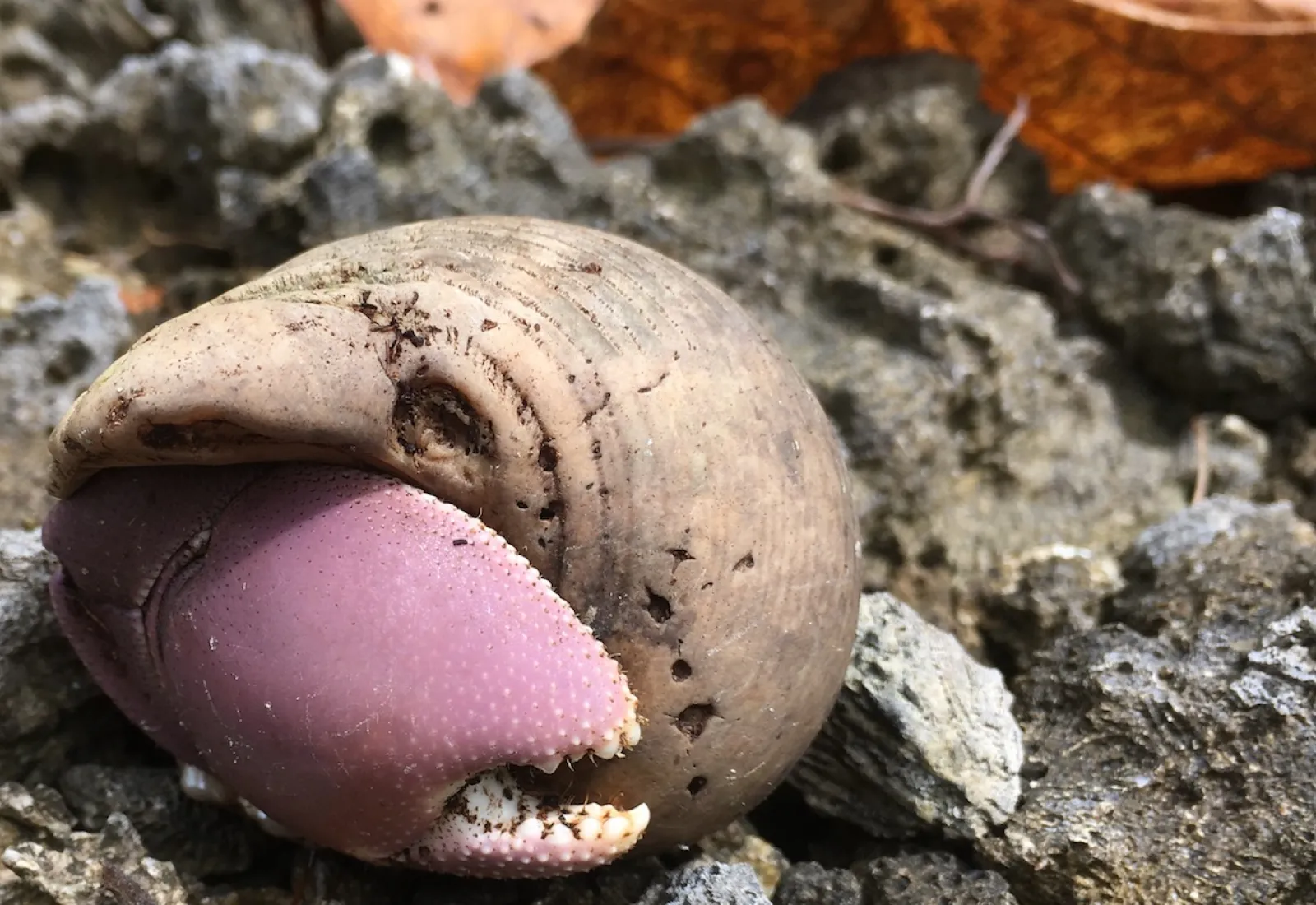For the month of May, we are featuring a critter who is helpful, social, and keeps us from being bored. Just watching them cruising on the beach or in the forest can bring a smile.
Strawberry Hermit crab is a funny name for a decapod (ten-legged) seemingly gregarious crustacean. This land hermit crab, U’a in Tahitian, displays a yellow spotted and vibrant red-orange coloured exoskeleton (external skeleton). With its 3.1 inches in size (an honourable size for hermit crab on atolls) it is very striking and contrast with the dazzling white of Tetiaroa’s beaches, however you’re much likely to observe it in the shade of vegetation, protected from heat and desiccation.

The home shell is a key to their survival, and helps them to hold a supply of both salt and fresh water, keeping their gills wet and regulating the osmotic pressure of their body fluids.
Females incubate their eggs inside of the shell before releasing the larvae into the sea.
Hermits usually never stray too far from shoreline. They like to cluster around trees, especially the Beach Heliotrope, tohonu in Tahitian (Heliotropium foertherianum), and climb them. They can climb all the way to the tip of branches to eat the young leaves. They also like to gather amidst the prop roots of the Pandanus tectorius, Fara in Tahitian.

Strawberry hermit crabs are gregarious critters.

Hermit in the forest
Like most arthropods (jointed-legs), Coenobita perlatus is an omnivorous scavenger which makes it an efficient beach cleaner. More active in night time, they eat just about anything and everything they come across, such as dead or wounded rats, crabs, baby turtles, stranded fish, or pandanus fruit, etc. They even eat their molted skin.
Speaking of molting, this physiological process is vital for crabs to develop. Indeed, once or twice a year, in order to grow bigger, they must shed their old skin and form a new exoskeleton. Meanwhile they must remain buried in the ground for one or two months.
These animals are heavily slowed down by the weight of their homes on their backs. They use empty sea snail shells (in Tetiaroa, predominantly that of Turbo setosus, ma’oa in tahitian ), after the snail has died. These tough shells works perfectly as portable homes, into which they can retract their entire bodies, close the opening with their thick claw, and protect their soft and twisted abdomen from predators.
They aren’t usually shy, and are easy to find, pick up, and manipulate. They’ll 'run' up and down an arm or a leg, but kids (and their small fingers) must be careful of their strong pinchers, which are sharp enough to cut open skin.


Hermits often gather to exchange shells.
Crabs remodel shells by combining chemical secretions to weaken the calcium carbonate and physically sculpt the shell's interior using their appendages. But only the small crabs can do the job, though. Their small size enables them to fit in untouched shells. Still such process costs huge effort for a tiny crab, so only when the availability of remodeled shells is low will small crabs invest in remodeling. Remodeled shells are a valuable and scarce resource on the market, this forces crabs to keep on the lookout for opportunities.
Competition for shells typically begins with one crab climbing onto the back of the shell of another crab, gauging the other’s shell size and assessing its relative strength. Then they jostle each other which attracts more crabs, who see a potential eviction for one and a potential free house for another. It sometimes ends by several crabs lining-up, in size order, each crab holding onto the shell of the crab ahead. If the foremost is evicted, then each crab moves into the bigger shell ahead of it. It’s a very entertaining performance and turns out to be also very interesting.
The social structure and gregariousness of hermit crabs is understood to aid in success and survival, since the prime, remodeled shells are only to be acquired by 'hanging with the big guys'. Eventually we realize that certain species of HERMIT crabs are not that asocial organisms, quite the contrary, they depend on each other to maintain population healthy and secure a beneficial niche.


